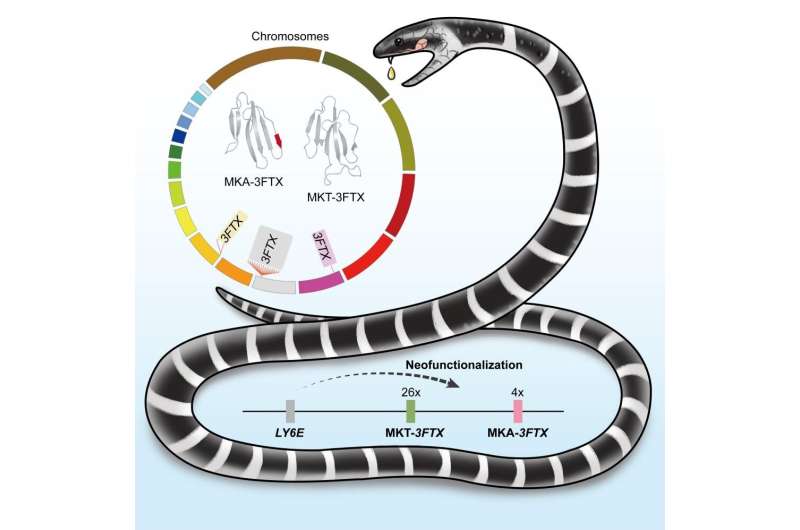Snake genome research expands understanding of krait venom

Bungarus multicinctus, or the many-banded krait as it commonly called, is a highly venomous elapid snake widely distributed across southern Asia. Available antivenoms show good neutralizing efficacy but can exhibit batch-to-batch variation and elicit severe allergic reactions, which may be due to poorly defined antivenom components.
Therefore, clarifying the full repertoire and composition of B. multicinctus toxin genes is needed to facilitate the development of next-generation antivenom with well-defined composition.
To comprehensively identify B. multicinctus toxin genes and reveal the evolutionary trajectory of the "three-finger toxins (3FTXs)"—so named because of their finger-like structure—produced by elapid snakes, a research team led by Prof. Li Jiatang from the Chengdu Institute of Biology (CIB) of the Chinese Academy of Sciences (CAS) recently completed a chromosome-scale reference genome of B. multicinctus and conducted comparative genomic analyses with seven other snake genomes.
Previous studies had shown that B. multicinctus venom contains various subtypes of 3FTX, one of the most abundant and diverse toxin families in elapid snakes. Until now, however, the lack of high-quality genome references had hindered the evolutionary study of the toxin family.
According to Li, studying the mechanisms that generated the 3FTX family can help show how venom systems evolved in elapid snakes. He said it would "help clarify their structure-function relationships." In addition, having this understanding could be used to "predict the likely activity of newly discovered toxins, reveal the neural transmission processes, and elucidate the pathogenesis of neuromuscular diseases," Li noted.
Based on their high-quality reference genome and multi-tissue transcriptomes, LI and his team found a total of 118 toxin genes from 17 families in B. multicinctus, including 30 3FTX, nine PLA2 I, and 31 KUN genes, whose expression can make up more than 90% of the venom gland transcriptome.
Further comparative genomic analyses suggest that the 3FTX family likely evolved through the neofunctionalization of flanking LY6E and diverged into two subfamilies, MKA- and MKT-3FTX, before the evolution of elapids.
The MKT-3FTX subfamily expanded and diversified substantially in B. multicinctus and is expressed actively in the venom gland. However, in the long-neglected MKA-3FTX subfamily, only one gene copy, which evolved a different protein conformation, was under positive selection and actively transcribed in the venom gland, thus functioning as a major toxin effector together with MKT-3FTX subfamily homologs.
The study provides valuable resources for further evolutionary and structure-function studies of snake toxins, which are fundamental for the development of effective antivenoms and drug candidates.
Results have been published in an article in Cell Reports.
More information: Zhi-Yi Zhang et al, The structural and functional divergence of a neglected three-finger toxin subfamily in lethal elapids, Cell Reports (2022). DOI: 10.1016/j.celrep.2022.111079
Journal information: Cell Reports
Provided by Chinese Academy of Sciences





















